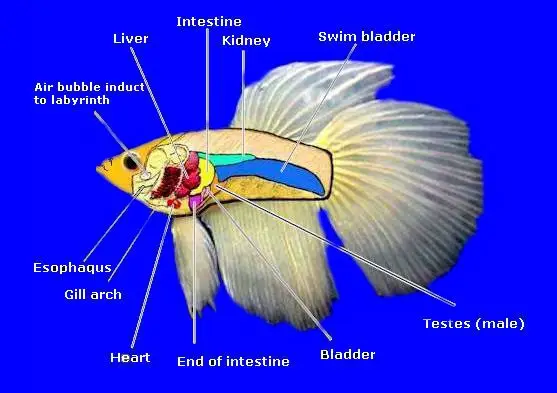Affiliate Disclaimer:
FishKeepingAnswers.com is reader-supported. When you buy through links on our site we may earn a commission.
For many of us Betta keepers our bettas are more than just fish, they are pets. For some people, their Bettas are even part of the family. As such, it can be distressing when our Bettas are unwell.
A Betta swimming vertically (pointing straight up or straight down) can be very upsetting. In this article I look at why a Betta might be swimming vertically, and how we can solve the problem.
The most common reason a Betta is swimming vertically is that they are having an issue with their swim bladder. A fish’s swim bladder allows a fish to stay neutrally buoyant in the water. When the swim bladder is damaged or otherwise compromised a Betta will struggle to swim normally.
Why is my Betta swimming vertically?
Normally, for most fish, a horizontal swimming position is most natural. With some exceptions, like members of the Headstander family of fish, fish like to swim from left to right and vice-versa, moving up and down as required.
Sometimes, a Betta may be unable to stay horizontal and may end up stuck in a verticle position. The most common reason this happens is because of an issue with the Bettas swim bladder.
What is a swim bladder?
A fish’s swim bladder is a gas-filled organ that allows the Betta to stay neutrally buoyant in the water so they don’t have to waste energy whilst not actively swimming. The swim bladder naturally expands and contracts to allow the Betta to effortlessly control its position in the water.
In simple terms, a swim bladder allows a Betta to ‘balance’ in the water.
When there is a problem with the Bettas swim bladder, the Betta will struggle to stay upright in the water. He may roll around, trying to stay upright or float belly up in the water. Sometimes a Betta will end up swimming pointing straight up or straight down due to swim bladder issues.

What causes Swim Bladder Disorder?
There are several different causes of Swim Bladder Disorder. These include;
Constipation
Constipation is probably the most common cause of swim bladder disorder.
Betta fish are well known as overeaters. They will gorge themselves on whatever food they can find, and this tendency to overeat can cause constipation.
Another cause of constipation in Betta fish is feeding the Betta cheap or poor-quality food. Cheap fish food often has a lot of ‘fillers’ in it. Fillers offer the Betta fish no nutritional value and are purely there to fill out the food, meaning you get more for your money.
When a Betta is constipated, its stomach and intestines can begin to swell. The swelling happens either because the Betta continues to eat even after becoming constipated or because the food that is stuck in their intestines starts to give off gases as it breaks down, causing the intestines to swell.
As the stomach or intestines swell they push on the swim bladder and can even cause it to move slightly.
Once moved, even slightly, the swim bladder no longer functions properly and the Betta will struggle to remain neutrally buoyant in the water.
Infection or parasites
When a Betta fish has either an internal infection or internal parasites, the resulting internal swelling or fluid retention causes the swim bladder to move or otherwise be compromised.
Tumors, kidney disease, and large tapeworms can all cause a Bettas body to swell and apply pressure to the swim bladder causing the Betta to lose the ability to remain upright.
Physical Damage
It is possible for a Betta to physically damage its swim bladder, although this is fairly rare in our aquariums.
The most common cause of swim bladder damage is when another fish deliberately rams into the Betta. There are a number of predatory fish that use this technique to immobilize their prey. The predator fish will swim at the prey fish at speed and deliberately ram into its side. the resulting collision may rupture the swim bladder of the prey fish, allowing the predator to catch and consume it without a drawn-out chase.
Curing constipation in a Betta fish
The good news about constipation is that it can usually be cured fairly quickly and easily.
The easiest way to cure constipation is by feeding the Betta a high fiber food. The hope is that the high fiber food essentially pushes the blockage out of the Betta and relieves constipation.
Before feeding your Betta some high-fiber foods, fast him for 3 days. During this time don’t feed him anything. The benefits of fasting the Betta are first, it increases the chances he will actually eat the high fiber food, and secondly, it gives him a chance to pass the blockage naturally.
The most commonly used high-fiber food is garden peas.
Peas are super high in fiber and most fish will happily eat them. To feed your Betta a pea, firstly cook it thoroughly. Personally, I use the microwave to blast the peas, but you could also boil them.
Once cooked, carefully squash the pea between your finger and thumb. This will pass the pea out of its skin, and turn it into smaller pieces which will be easier for the Betta to eat.
Add a very small piece of a pea to your Bettas tank. If he eats it, add a little bit more. Don’t make the mistake of overfeeding him. If necessary, save a little of the pea and give it to him again in a couple of hours.
Feed the Betta peas for about a week, constantly checking for the Betta passing a stool. If your Betta passes the blockage and begins to swim normally you know you have cleared constipation.
An alternative to feeding peas would be to feed your Betta live or frozen daphnia. I swear by daphnia both as a cure for constipation and as a preventative. Daphnia has a laxative effect on bettas, helping keep their internal system clear and running freely.
Curing infection or internal parasites
If you believe your Betta fish is having swim bladder issues due to internal infection or parasites, or you have tried the method above without success, I would suggest treating your Betta with a course of ParaCleanse.
ParaCleanse, which is made by Fritz, works on internal tapeworms and helps cure general internal swelling.
I have used ParaCleanse to great effect in the past, and I use it as part of my quarantine procedure for all new fish that enter my fish room.
If your Betta is living in a community aquarium with other fish, consider moving him to a dedicated hospital tank before commencing treatment, just in case he passes any pest or infection onto the other fish in his tank.
Comprehensive Parasite Treatment: Fritz ParaCleanse is expertly formulated to treat a wide range of parasitic diseases in aquarium fish, including velvet (Oodinium), hole-in-the-head disease (Hexamita & Spironucleus), fish lice, and gill & skin flukes (Dactylogyrus & Gyrodactylus), ensuring a healthy environment for your fish.
Aquarium-Friendly Formula: Designed to be safe for both freshwater and saltwater systems, this treatment does not discolor water, harm plants, invertebrates, or uninfected fish, maintaining the aesthetic and ecological balance of your aquarium.
Dual-Action Active Ingredients: Containing Metronidazole and Praziquantel, Fritz ParaCleanse is not only effective against a variety of parasites but also some internal bacterial infections, offering dual-action treatment for comprehensive fish care.
User-Friendly Dosing: The easy-to-measure packet dosing system simplifies the application process, making it accessible even for novice aquarium enthusiasts. Bulk jars are also available for larger systems, catering to a range of aquarium sizes.
Specific Treatment Indications: While highly effective against specific parasites, it is important to note that ParaCleanse does not treat Nematodes or Roundworms. For these, Fritz Expel-P is recommended, ensuring targeted and effective treatment for different parasitic infections.
Last update on 2025-04-01 / Affiliate links / Images from Amazon Product Advertising API
The video below from Aquarium Co-op has good advice about using ParaCleanse.
Preventing constipation in a Betta
Preventing constipation in the first place is far better than having to cure it further down the line.
The simplest way to prevent constipation is to feed your Betta a high-quality, varied diet.
Over many years I have come up with a diet which means I now almost never come across constipation in any of my Bettas.
First, feed only good quality pellet foods. I swear by Bug Bites from Fluval. They are made primarily from Black Soldier Fly Larvae and are high in protein I have also fed a lot of Vibre Bites from Hikari.
Next, vary the diet as much as possible. I like to feed my Betts frozen or live bloodworms, daphnia, and mosquito larvae. I also feed my Bettas ants, aphids, and fruit flies when I have them available.
The more variety we give our Bettas the less chance they will become constipated.
Another great way to reduce the chances of a Betta becoming constipated is to feed little and often. I feed my fish 2 or 3 times a day, a little each time, rather than dumping a load of food all in the tank in one go.
- Betta fish food that contains up to 40%, nutrient-rich Black Soldier Fly Larvae, the first ingredient
- High in multiple proteins like whole salmon – rich in Omega 3 and 6 for healthy skin, scales and fins
- Fortified with essential vitamins, amino acids and minerals for a balanced daily diet
- Slow sinking micro granule format (0.25-1.0mm) – all fish can feed at their preferred depth; feed as much as fish can eat in two minutes, two or three times daily
- Sustainably processed in small batches for quality control and maximum freshness
Last update on 2025-04-01 / Affiliate links / Images from Amazon Product Advertising API
My Final Thoughts on ‘Why is my Betta swimming vertically?’
The most likely reason a Betta is swimming vertically is due to swim bladder disorder, which is usually caused by constipation.
Following the steps above will help you determine the cause of the Betta swimming in a vertical position, and the most likely way to remedy the situation.











